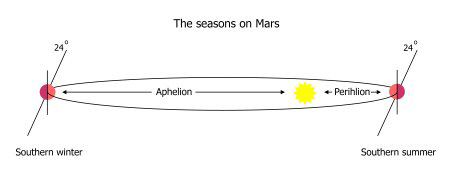The seasons on Mars
 The seasons on Mars
The seasons on Mars
Similarly to Earth, Mars has four distinct seasons. However, each season lasts about twice as long because the Martian year is almost twice that of Earth. Mars orbits closest to the Sun when its southern hemisphere is tilted towards it, while the northern hemisphere is tilted towards the Sun when it is furthest away. The southern summer is therefore much hotter than the northern summer. This extra heat pouring into the southern hemisphere causes greater turbulence and drives stronger winds, stirring up the largest storms.
In springtime, the polar ice cap starts to recede and may even disappear from view altogether by the summer. The carbon dioxide released from the melting ice makes the atmosphere thicker. Once autumn arrives, the polar cap of that hemisphere starts to grow again as temperatures drop, sometimes reaching the middle latitudes in winter. In northern summer, clouds can form, especially around the top of volcanoes. At other times of the year, heat rising from the tropics, the region either side of the equator, can make cloud bands form in this region, in much the same way as on Earth. Beagle 2 may witness some of these clouds overhead. However, no dust cloud on Mars ever produces rain although it is possible that frost layers could temporarily form on the planet's surface. Even in summer, Mars is hardly hospitable in its temperatures, with lows that reach -140°C. However, the occasional high of 20°C may eventually attract holidaymakers.

The Martian orbit is considerably more elliptical than Earth's, which means that for part of the year the planet is quite a bit closer to the Sun than at other times. The hemisphere that is tilted towards the Sun at the time of closest approach (perihelion) will experience a hotter summer than the other hemisphere, which will be tilted towards the Sun at the furthest approach (aphelion). As planets travel fastest when closest to the Sun, the hemisphere with the hotter summer will also have a shorter summer. Mars's southern hemisphere is tilted towards the Sun at the time of closest approach.
